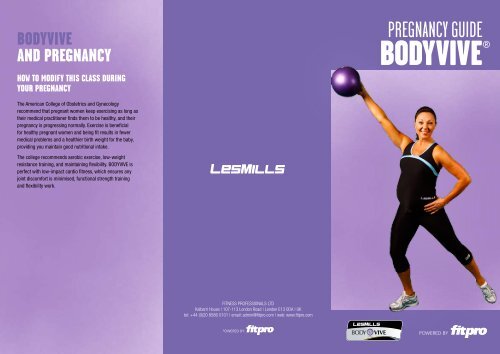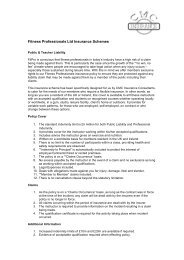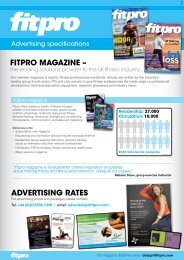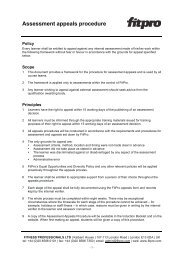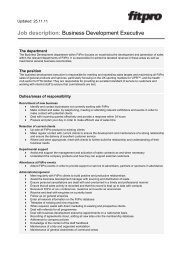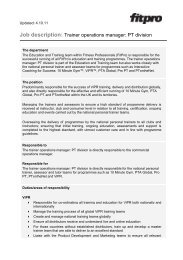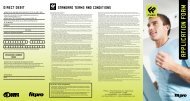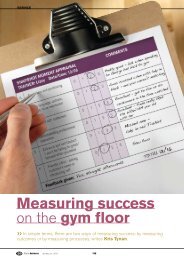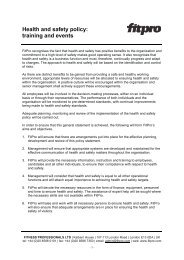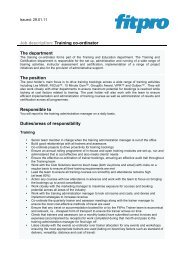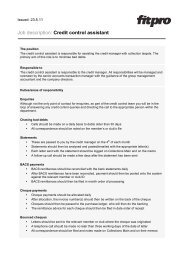pregnancy guide - Fitness Professionals
pregnancy guide - Fitness Professionals
pregnancy guide - Fitness Professionals
You also want an ePaper? Increase the reach of your titles
YUMPU automatically turns print PDFs into web optimized ePapers that Google loves.
BODYVIVE<br />
AND PREGNANCY<br />
HOW TO MODIFY THIS CLASS DURING<br />
YOUR PREGNANCY<br />
PREGNANCY GUIDE<br />
BODYVIVE ®<br />
The American College of Obstetrics and Gynecology<br />
recommend that pregnant women keep exercising as long as<br />
their medical practitioner finds them to be healthy, and their<br />
<strong>pregnancy</strong> is progressing normally. Exercise is beneficial<br />
for healthy pregnant women and being fit results in fewer<br />
medical problems and a healthier birth weight for the baby,<br />
providing you maintain good nutritional intake.<br />
The college recommends aerobic exercise, low-weight<br />
resistance training, and maintaining flexibility. BODYVIVE is<br />
perfect with low-impact cardio fitness, which ensures any<br />
joint discomfort is minimised, functional strength training<br />
and flexibility work.<br />
FITNESS PROFESSIONALS LTD<br />
Kalbarri House | 107-113 London Road | London E13 0DA | UK<br />
tel: +44 (0)20 8586 0101 | email: admin@fitpro.com | web: www.fitpro.com
MOVEMENT OPTIONS FOR CORE<br />
& RESTORE IN DETAIL<br />
All of the following moves are suitable options during the Core &<br />
Restore section of a BODYVIVE class.<br />
Our main focus is minimising lying on the back from week 13 of<br />
<strong>pregnancy</strong> and avoiding it altogether in the third trimester.<br />
BACK CARE OPTIONS<br />
CAMEL<br />
Place VIVE ball between knees and bring toes together.<br />
Squeeze buttock muscles tight and use hands at the lower<br />
back for support.<br />
WAITER'S BOW<br />
Place VIVE ball between knees and bring<br />
toes together. Sit hips back a little and lean<br />
forward, keeping length through your spine.<br />
The single arm option is easier or two arms<br />
with the VIVE tube for more challenge.<br />
CAT CURL<br />
Place VIVE ball between knees, line up hips above<br />
knees and shoulders above wrists. Lift and curve<br />
spine towards the ceiling, then release to a neutral<br />
spine.<br />
BRIDGE<br />
Lying on back, feet in close to butt, lift hips,<br />
squeezing buttock muscles.<br />
SIDE-LYING LEG EXTENSION<br />
Lying on side with hips stacked one<br />
on top of the other; bottom leg is<br />
bent to help balance. Keeping the<br />
toes forward, extend the top leg<br />
forward and back.<br />
HORSE STANCE POINTER<br />
On hands and knees, line up hips above knees and shoulders above<br />
wrists. Extend one arm and opposite leg away from each other out to<br />
the diagonal. Keep hips and shoulders level. Option to have hand on<br />
the floor or lifted. Bring the extended leg and arm in together under<br />
body, curving the spine towards the ceiling.<br />
ABDOMINAL OPTIONS<br />
SIDE PLANK<br />
Lying on side, place the VIVE ball<br />
between your knees. Elbow is below the<br />
shoulder, lift hips up either supporting<br />
belly with free hand or extend to the<br />
ceiling.<br />
HIP DROP<br />
Place VIVE ball between knees, hips slightly<br />
forward of knees and shoulders above<br />
wrists. Drop hips halfway to one side then<br />
return and repeat other side.<br />
HOVER<br />
On elbows and knees, hips forward of<br />
knees and shoulders above elbows. Keep<br />
a long straight spine and hold.<br />
ABDOMINAL TOE TAPS<br />
(up to 6 months only)<br />
Lying on back, belly braced and back<br />
close to the floor. Lift one knee at a time<br />
up to the chest and return. Option to<br />
extend arms overhead while lifting the<br />
knee.<br />
STRETCH OPTIONS<br />
HAMSTRING STRETCH<br />
Seated with legs extended and apart in front.<br />
Lean forward keeping a long spine till you<br />
feel hamstring stretch.<br />
CHILD’S POSE<br />
Kneeling toes together and knees apart.<br />
Sink back on to heels and drape body<br />
forward hands on VIVE ball to give lift<br />
and prevent belly dropping to the floor.<br />
FAQs<br />
Q In the cardio section, how hard and how long can I work out?<br />
A Exercise capacity becomes reduced because during <strong>pregnancy</strong>,<br />
even at rest, heart and lungs have to work harder. You can work<br />
out at a moderate pace, which feels “somewhat hard”, for 30-45<br />
minutes on most days. However, anyone new to exercise should<br />
build intensity and duration up gradually to a moderate level.<br />
Q What safety aspects do I need to consider?<br />
A There are a few simple safety points to working out during<br />
<strong>pregnancy</strong>:<br />
1. Avoid overheating. Metabolism is raised when pregnant, so you<br />
already produce more heat, and exercise increases heat production<br />
further. Even though this has not been shown to be a problem for<br />
the baby, we feel it’s important to keep this controlled. So, wear<br />
clothing that allows heat to escape and exercise in a comfortable<br />
temperature. Another way we keep cool is through the evaporation of<br />
sweat. This is where hydration is important – if you get dehydrated<br />
you sweat less and can overheat more easily – so drink plenty!<br />
2. Don’t push flexibility later in <strong>pregnancy</strong> because ligaments get<br />
looser as the body produces the hormone relaxin and starts to<br />
prepare for delivery.<br />
3. Take a wider foot stance to maintain steady balance as this can<br />
be affected due to an altered centre of gravity.<br />
Q What about abdominal exercises, should I keep doing them?<br />
A Abdominal exercises may need to be altered, especially in the<br />
last trimester. In the last three months it is best to avoid being on<br />
your back for extended periods of time, as the weight of the baby<br />
can restrict blood flow back to the heart and cause dizziness. Some<br />
women will feel more comfortable doing this from about week 13.<br />
Q Should I eat differently during <strong>pregnancy</strong>?<br />
A During <strong>pregnancy</strong> carbohydrate requirements increase as it is<br />
the body’s preferred fuel. It makes sense to increase carbohydrate<br />
intake and is a good idea to have some carbohydrate before and<br />
after exercise.<br />
Q When can I start exercising again after I’ve had my baby?<br />
A The good news is you can get back into exercise two weeks<br />
after having baby, providing it was a normal delivery and all is<br />
healthy and normal. Focus on pelvic floor exercises and minimise<br />
bouncing moves for about six weeks.


